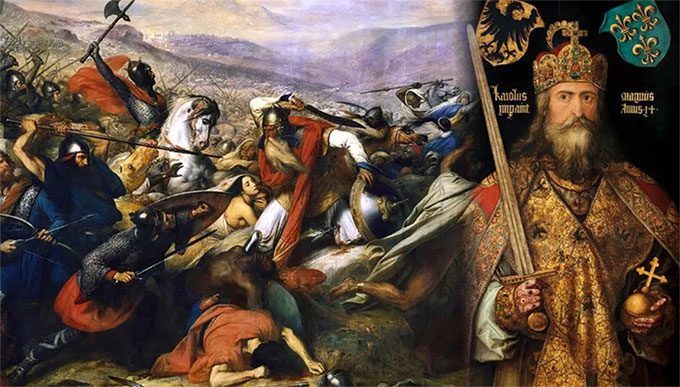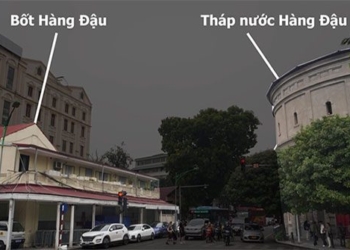If the Moors had won, much of Europe could have come under Islamic rule.
The Battle of Poitiers, also known as the Battle of Tours, took place over the course of a week in early October 732. The two opposing forces were the Frankish army led by King Charles Martel against the invading Islamic forces under the Umayyad dynasty from Damascus (Syria). The two armies clashed as the Umayyads sought to expand their power into Europe, while the Frankish lords aimed to protect and consolidate their territorial control.
The Ambitions of the Umayyad

Illustration of the Battle of Tours in October 732. (Photo: The Collector).
The Umayyad dynasty was a highly prosperous political and religious empire that developed in the 7th century in Arabia following the death of the Prophet Muhammad in 632.
Under the Umayyads, the territory rapidly expanded. This Islamic dynasty became one of the largest unified states in history and one of the few that extended direct rule over three continents: Africa, Europe, and Asia. The Umayyad dynasty incorporated regions such as the Caucasus, Transoxiana, Sindh, the Maghreb, and the Iberian Peninsula into the Islamic world. At its height, the Umayyad kingdom covered 14.9 million km2, with a population of 62 million (29% of the world’s population), making it the fifth-largest empire in history both in area and population.
Within just a few decades, Umayyad power extended westward to Morocco and the Iberian Peninsula. The Umayyads enlisted the Moorish people—a nomadic tribe from North Africa—into their military. They were among the most zealous converts, determined to spread Islam by force. With their warrior spirit, the Moors significantly disrupted the existing power balance, capturing most of the cities south of the Pyrenees (Spain) by 711. On the offensive, the Moors began to raid northward across the Pyrenees into Frankish territory (France).
The Power of the Franks in Western Europe
The Frankish tribes first rose to power after the decline of the Roman Empire around the late 5th century. Renowned as great warriors, these Germanic tribes filled the power vacuum left by the waning Roman influence across Gaul (present-day northern France, Belgium, and western Germany). As early as 481, a Frankish leader named Clovis unified various Frankish tribes, converted to Christianity, and established the Merovingian dynasty, which ruled for about 250 years.
The Merovingian court was marked by violence, with assassinations occurring frequently, leading to a gradual decline in governance. Over time, Frankish power became fragmented among regional governors.
When one of the early significant governors—Pepin II—died, a succession crisis ensued among his potential heirs. Ultimately, Pepin’s illegitimate son, Charles, emerged as the leading candidate. Charles spent most of his reign consolidating power, fighting and quelling revolts following the death of Governor Pepin II. He commanded 11 major campaigns from 715 to 731, gaining valuable experience and earning the trust of his allies. However, it took time for Charles to solidify control and gain independence in regions like Aquitaine in the south. Aquitaine inadvertently played a crucial role as a buffer zone between the Umayyad forces and the Frankish army.

Portrait of King Charles Martel of the Franks. (Photo: National Museum of American History).
Conflict Between the Umayyad and the Franks
Aquitaine was a semi-independent province in the early 8th century, nominally claimed by the Frankish kingdom but governed by a skilled military commander, Eudes. Eudes also sought power following Pepin II’s death.
Aquitaine bordered the lands of Spain that the Umayyads had recently conquered. Although Eudes achieved some successes, most notably countering a major attack on the city of Toulouse in 719, eventually, in 732, the Umayyad forces led by the Spanish governor Abd al-Rahman ibn Abd Allah al-Ghafiqi defeated Eudes’s army in Aquitaine, plundering the entire region.
In defeat, Eudes was forced to move northward to seek assistance from Charles. Although they were not on friendly terms, Charles agreed to help.
The battle in the town of Tours occurred on October 10, 732, near the confluence of the Clain and Vienne rivers, on a relatively open plain surrounded by woods.
While Abd al-Rahman’s army primarily relied on the fierce Moorish tribes, the Frankish forces included a diverse array of multilingual peoples. Both armies employed infantry, with the Umayyad’s advantage being a fully equipped cavalry. While the Umayyad forces were estimated to number around 20,000 to 25,000, the Frankish army ranged from 15,000 to 20,000 troops.
Recognizing the Umayyad’s reliance on cavalry and general offensive tactics, King Charles arranged his troops into a phalanx formation (a dense rectangular formation) to repel the Umayyad assault.
Fighting continued until rumors spread throughout the Umayyad camp that their supply train was being raided by the Franks, causing panic and breaking their discipline. The Arab commander Abd al-Rahman was killed while trying to re-establish control over the army in the camp.
Becoming a “headless snake,” the Umayyad forces retreated overnight, and the Frankish army achieved victory. Eudes and his troops were tasked with pursuing the remaining Umayyad soldiers while King Charles marched back north.
To this day, the question of the significance of Tours as a pivotal moment in history remains debated. King Charles’s victory in 732 helped prevent the Umayyad dynasty from settling in Frankish territory, at least for that year. However, many historians argue that Tours was not the decisive conflict it is often described as. They contend that the Arab raids launched in 734, 736, and their largest invasion in 739, when they nearly advanced as far as Dijon before being repelled by the Frankish and Lombard forces, were the true pivotal moments.
Yet some experts argue that the importance of the Battle of Tours does not necessarily lie in the battle itself. In fact, it ignited a “fire” of internal conflict within the Umayyad dynasty and led to the later revolt of the Moorish tribe in Morocco.
With no stable supply of troops and failing to attract participants through pillaging, the Umayyad army in Spain had to retreat behind the Pyrenees, gradually weakening and losing the capacity to continue raiding Frankish lands.
The Battle of Tours brought prestige and military power to King Charles. He was regarded as the savior of Christianity following his victory over the Muslims.
After the battle at Tours, Charles was recognized as the supreme authority in the kingdom, allowing him to consolidate power around himself. One of the ways he did this was by rewarding his loyal followers with lands owned by the Church. Charles not only helped strengthen the loyalty of his supporters through gifts but also enhanced control over the lands within his kingdom by assigning them to trusted military commanders.




















































